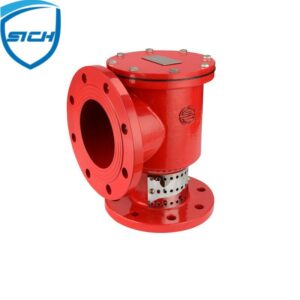Foam concentrate is mixed with the water stream in a specific ratio to create the foam solution. The mixing process typically involves the use of proportioning devices or foam proportioners.
There are different types of foam proportioning systems commonly used to mix foam concentrate with water, including:
- Inline Foam Proportioners: Inline foam proportioners are installed in the water supply line, usually downstream of a water pump or water source. These devices utilize the pressure energy of the water flow to draw and mix the foam concentrate into the water stream. Inline proportioners can operate based on different principles, such as venturi or orifice-based designs.
- Venturi-based proportioners use a constriction in the water flow path to create a pressure differential. This pressure differential draws the foam concentrate into the water stream, and mixing occurs in the venturi chamber.
- Orifice-based proportioners use a calibrated orifice and pressure differential to create a vacuum, which pulls the foam concentrate into the water stream for mixing.
- Balanced Pressure Proportioners: Balanced pressure proportioners are typically used in high-flow systems or situations where a constant foam solution ratio is required. These devices use a balanced pressure principle to proportion and mix the foam concentrate with water. They consist of a chamber with diaphragms or pistons that move in response to changes in pressure, allowing the foam concentrate to be proportioned accurately into the water stream.
- Foam Eductors: Foam eductors, also known as inductor nozzles or foam nozzles, are handheld or portable devices used for mixing foam concentrate with water at the nozzle itself. They are commonly used by firefighters during firefighting operations. china foam chamber factory Foam eductors are designed with an internal venturi or orifice system that creates a pressure differential, drawing the foam concentrate into the water stream and mixing it to form foam.
In all these proportioning systems, the foam concentrate is stored in a separate tank or container, and it is typically supplied under pressure or with the help of a foam concentrate pump. The foam concentrate is introduced into the water stream at the appropriate ratio, often specified by the foam manufacturer or based on specific fire protection standards.
The foam proportioning systems ensure accurate and consistent mixing of foam concentrate with water, creating a foam solution of the desired concentration. This foam solution is then supplied to the foam chamber or other firefighting devices for application to the fire.
What are some advantages of using foam eductors for mixing foam concentrate with water?
Using foam eductors for mixing foam concentrate with water offers several advantages in firefighting operations. Here are some of the benefits of using foam eductors:
- Portability and Flexibility: Foam eductors are typically handheld or portable devices, allowing firefighters to easily transport and deploy them in various firefighting scenarios. They are lightweight and compact, making them suitable for use in different locations and environments.
- Simplicity of Operation: Foam eductors are relatively simple to operate, requiring minimal training. Firefighters can quickly connect them to a water supply and foam concentrate source, and the mixing process occurs within the nozzle itself. This simplicity enables rapid deployment and efficient use during firefighting operations.
- Cost-Effective Solution: Foam eductors are cost-effective compared to other foam proportioning systems. They eliminate the need for complex and costly fixed proportioning systems, making them a practical choice for smaller-scale firefighting applications or situations where a temporary foam solution is required.
- Versatility: Foam eductors are compatible with various types of foam concentrates, including AFFF (Aqueous Film-Forming Foam), AR-AFFF (Alcohol-Resistant Aqueous Film-Forming Foam), protein-based foam, and synthetic-based foam concentrates. This versatility allows firefighters to select the appropriate foam concentrate based on the specific fire scenario.
- Adjustable Foam Concentration: Foam eductors often feature adjustable settings or controls that allow firefighters to vary the foam concentrate-to-water ratio. This adjustability enables them to optimize the foam concentration based on the type of fire, the fuel involved, and the desired firefighting outcome.
- Immediate Foam Production: Foam eductors provide rapid foam production at the nozzle, allowing firefighters to quickly apply foam to the fire. This immediate foam generation helps in suppressing the fire, reducing its intensity, and preventing its spread.
- Compatibility with Existing Equipment: Foam eductors can be easily integrated with existing firefighting equipment, such as fire hoses, nozzles, and monitors. They can be attached to the discharge side of a water pump or connected to a fire truck’s water supply, enhancing the foam delivery capabilities of existing systems.
- Durability and Reliability: Foam eductors are designed to withstand the rigors of firefighting operations. They are constructed with robust materials that can withstand high pressures and resist corrosion, ensuring their durability and reliable performance in demanding environments.
Foam eductors are a valuable tool in the firefighting arsenal, offering a portable, cost-effective, and efficient solution for mixing foam concentrate with water. Their ease of use, versatility, and immediate foam production make them a preferred choice in many firefighting applications.
